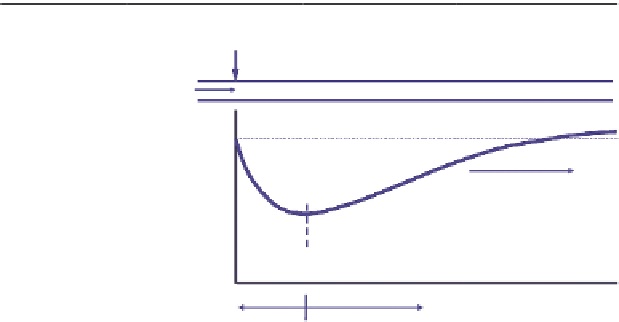Environmental Engineering Reference
In-Depth Information
Anaerobic environments are common in aquatic sediments, below the thin oxidized surface
layer, but anaerobic conditions in the water column are very undesirable and often symptomatic of
pollution. Anaerobic environments are also referred to as anoxic, and water with a diminished sup-
ply is referred to as hypoxic. Another phrase in common usage today to describe hypoxic waters is
dead zones
. Dead zones are becoming increasingly common in a variety of aquatic habitats.
So, how much oxygen is necessary for a healthy aquatic environment? The amount would vary
with the type of environment and what could be considered healthy. One measure is the regulatory
standards and criteria proposed by the U.S. EPA and adapted by state agencies. The ambient dis-
solved standards included in the U.S. EPA's quality criteria for water (USEPA 1986) are listed in
Table 5.3. For cold-water environments and early life stages where intergravel (the hyporheic zone)
concentrations are critical, the ambient criteria are those that would be expected to result in the
intergravel concentrations given in parentheses. To relect the diel variations that may occur, some
states have adapted standards for both daily averages (such as 5 mg L
-1
) and instantaneous mini-
mums (such as 4 mg L
-1
).
DO standards and criteria are also used to determine how much material may be discharged into
a stream or river without violating those standards, used as a basis for establishing discharge per-
mits (wasteload allocations). The typical result of a discharge of organic materials into a stream is a
decrease in DO concentrations. However, the impact of the deoxygenation is not only a function of
the amount of material discharged, but also the combined function of all of the instream processes
impacting DO concentrations. The typical result is a longitudinal variation in DO concentrations,
as illustrated by the idealized DO sag curve illustrated in Figure 5.20.
TABLE 5.3
Ambient Dissolved Oxygen Standards (mg L
-1
)
Cold-Water Criteria
Warmwater Criteria
Early Life Stages 1,2
Other Life Stages
Early Life Stages 2
Other Stages
30-day mean
NA
6.5
NA
5.5
7-day mean
9.5 (6.5)
NA
6.0
NA
7-day minimum
NA
5.0
NA
4.0
1-day minimum
8.0 (5.0)
4.0
5.0
3.0
Source:
USEPA, Quality criteria for water 1986, United States Environmental Protection Agency, Ofice
of Water Regulations and Standards, Washington, DC, 1986.
River
DO
(mg L
-1
)
Saturation
Recovery zone
(plants)
Critical concentration
(decomposition = reaeration)
Distance
Decomposition
dominates
Reaeration
dominates
FIGURE 5.20
Dissolved oxygen sag. (From Chapra, S.C.,
Surface Water-Quality Modeling
, WCB McGraw-
Hill, New York, 1997.)




Search WWH ::

Custom Search